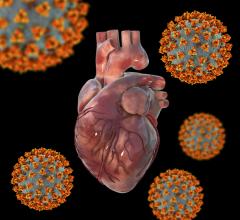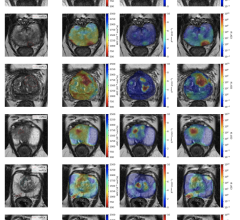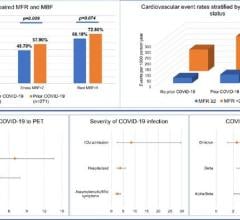
Image Credit: Getty Images
March 11, 2022 – A new study by physicians at Columbia University Vagelos College of Physicians and Surgeons has identified unique features of MIS-C, a rare but potentially deadly complication of COVID in children, that suggest how the syndrome gets started.
The findings may lead to faster diagnosis and better treatment of MIS-C (also known as multisystem inflammatory syndrome in children).
The study, led by Mark Gorelik, MD, assistant professor of pediatrics, and Robert Winchester, MD, professor of medicine, pathology & cell biology, and pediatrics, was published in the March issue of the Journal of Allergy and Clinical Immunology.
“One of the major unanswered questions about MIS-C is how, immunologically, the disease evolves from the initial infectious episode to the final, immune-mediated assault,” says Gorelik. “One way to study this could be to identify what is unique about the inflammatory/immunologic response in MIS-C.”
Though other studies have looked at the immune and inflammatory response in MIS-C patients, most have looked at patients after initiation of treatment and made comparisons with healthy controls. “To us, comparisons to healthy controls would not differentiate the basic inflammatory response to infection from the unique features of MIS-C, and, of course, treatment would muddy the waters,” says Gorelik.
Gorelik and Winchester’s team compared eight MIS-C patients with 14 patients who had other febrile infections, by looking at the array of immune cells and responses in blood samples taken at the very first encounter with care in the emergency department, before treatments were initiated.
Differences in immune cells
A clue to what causes MIS-C may lie in the different immune cells found in MIS-C patients compared with other patients.
“Only some cells were activated, which suggests that these cells are mistakenly directing the immune system to attack blood vessels in the body that had been damaged by the virus,” says Winchester. “These cells are drawn to the blood vessels because of the presence of the virus, but they appear to misidentify the culprit when they alert the rest of the immune system.”
MIS-C also appears to drive patients’ natural killer cells—another type of immune cell—to exhaustion. “They get to the point where they are no longer able to carry out their function properly,” Winchester says. “This is seen in some other inflammatory diseases and may offer a clue to treatment similar to those diseases.”
Faster diagnosis?
Another finding may give physicians an easier way to diagnose MIS-C, which can be hard to distinguish from other syndromes.
Notably, interleukin-27, an inflammatory molecule, was very highly upregulated in patients with MIS-C but not in other febrile children.
“This cytokine is poorly understood but has been associated with increased mortality in patients with serious blood infection or sepsis,” Gorelik says.
“If validated, these findings may allow researchers to run a simple, easily available test to readily confirm MIS-C in patients when they are in the emergency department.”
Similarities with severe disease in adults
The Columbia researchers postulate that MIS-C and adult COVID-19 infection may be more similar than is currently believed. “We noticed that several of our findings have also been reported in studies of adult patients with severe, late-stage COVID-19 infection,” Gorelik says.
“Perhaps—and this is highly speculative—what is unique to children is the ability to handle the initial viral infection more efficiently, and then a month or so later they develop MIS-C. In contrast, adults are not able to suppress the initial viral infection. And then secondarily, in severe cases, a serious MIS-C-like immune response develops. In both adults and children, however, this second phase immune signature appears quite similar.”
More information
Close collaboration with the pediatric and emergency medicine departments at Columbia University and co-authors Peter Dayan, MD, professor of pediatrics (in emergency medicine), and Tamar Lubell, MD, assistant professor of pediatrics (in emergency medicine), was instrumental to the study.
The study, published in the March print issue of the Journal of Allergy and Clinical Immunology, is titled “Upregulation of Conventional Dendritic Cells type 1 (cDC1) implicates antigen cross presentation in Multisystem Inflammatory Syndrome (MIS-C).”
All contributors: Janice J. Huang (Columbia), Samantha B. Gaines (Columbia), Mateo L. Amezcua (Columbia), Tamar R. Lubell (Columbia), Peter S. Dayan (Columbia), Marissa Dale (Columbia), Alexis D. Boneparth (Columbia), Mark D. Hicar (University at Buffalo Medical Center), Robert Winchester (Columbia), and Mark Gorelik (Columbia).
The research was supported by grants from the National Institutes of Health (K08 HL155033 25), the U.S. Public Health Service, and the American Heart Association.
The researchers declare no conflicts of interest.
Related Content on MIS-C:
Kawasaki-like Inflammatory Disease Affects Children With COVID-19
VIDEO: Overview of Multisystem Inflammatory Syndrome in Children (MIS-C) in COVID-19 Exposed Children — Interview with Deepika Thacker, M.D.
Case Study Describes One of the First U.S. Cases of MIS-C
Study Provides MIS-C Treatment Guidance To Avoid Cardiovascular Dysfunction
NIH-funded Project Wants to Identify Children at Risk for MIS-C From COVID-19
New Study Looks at Post-COVID-19 Emerging Disease in Children
The Cardiovascular Impact of COVID-19
VIDEO: Example of a Multisystem Inflammatory Syndrome in Children (MIS-C) Pediatric Echocardiogram
NIH-funded Project Wants to Identify Children at Risk for MIS-C From COVID-19


 March 20, 2024
March 20, 2024 









